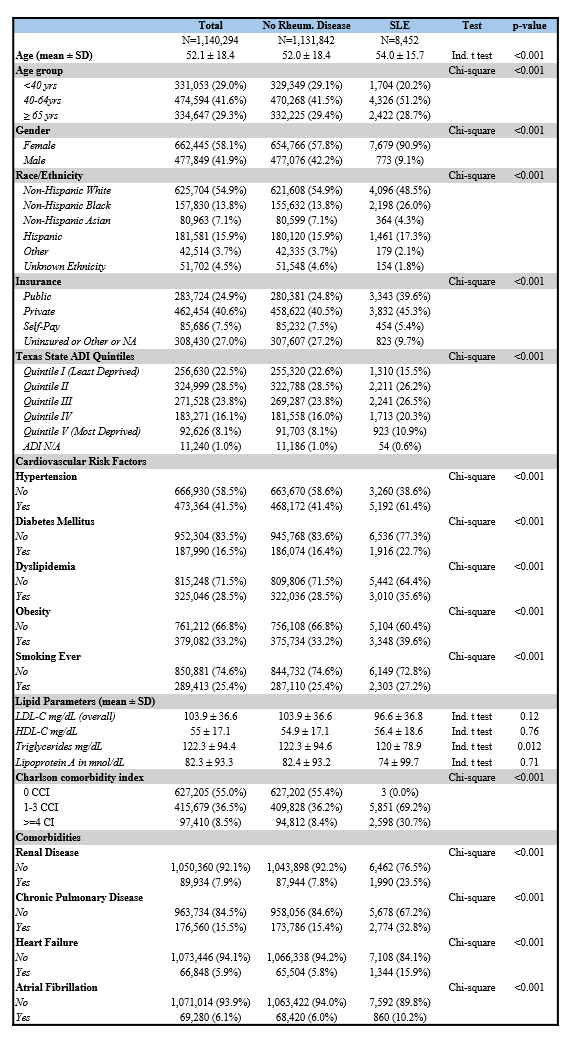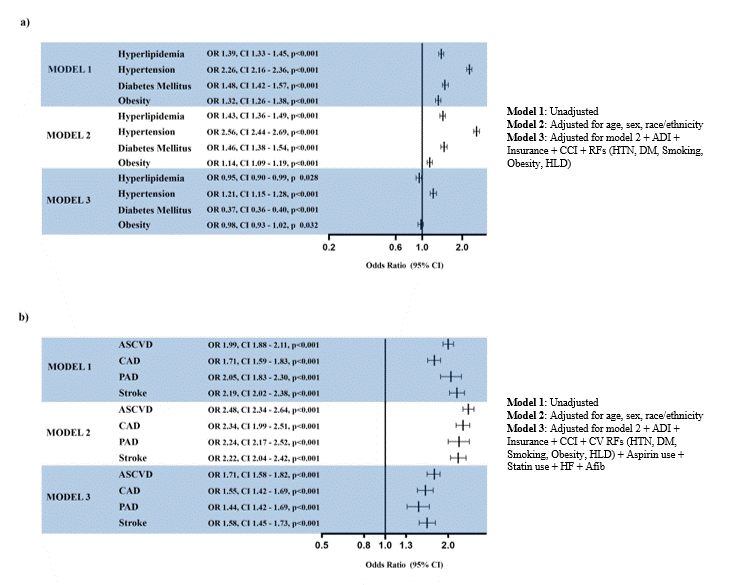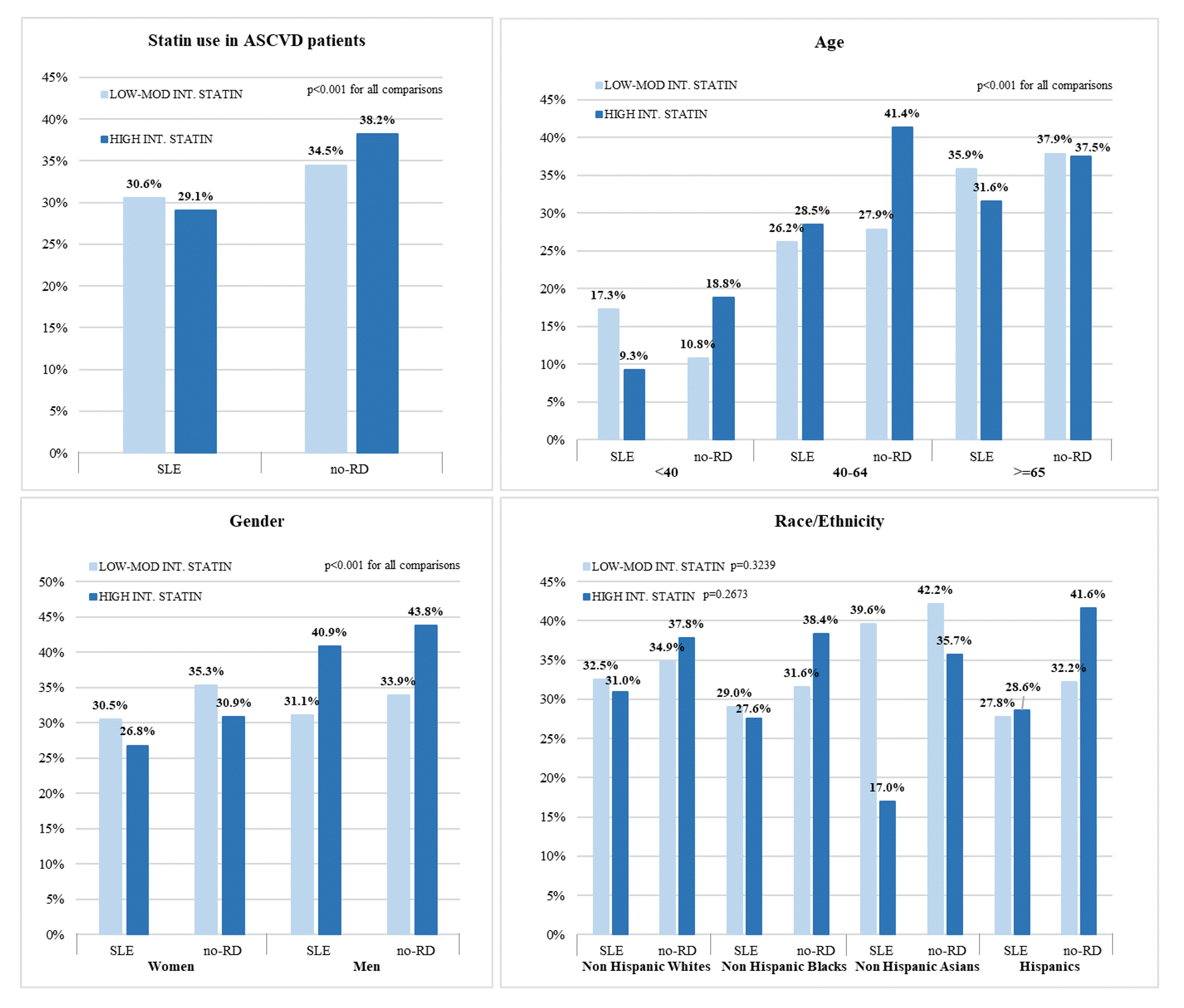Session Information
Session Type: Poster Session C
Session Time: 10:30AM-12:30PM
Background/Purpose: Patients with systemic lupus erythematosus (SLE) have increased prevalence of cardiovascular risk factors (RFs), which predispose to higher risk of premature atherosclerotic cardiovascular disease (ASCVD). Similar to the general population, patients with SLE with established ASCVD should be initiated on statin therapy for secondary prevention. The goal of this study is to determine the prevalence of cardiovascular RFs and ASCVD in patients with SLE compared to patients without rheumatologic disease (RD) and to evaluate the use of statin as secondary prevention in both groups. To the best of our knowledge, this is the first and largest single-center based registry cohort describing RF, ASCVD and secondary prevention with statin use in a SLE population.
Methods: The Institutional electronic medical record (EMR)-linked registry (The Houston Methodist Learning Health System Outpatient Registry) was queried to identify patients with SLE based on ICD-10 codes, between June 2016 and December 2022. Patients seen in the system in the same timeframe with no ICD-10 codes identifying RDs were used as a comparator. Multivariate logistic regression models were used to determine the odds of cardiovascular RFs and ASCVD in SLE versus no-RD patients. In the subset of patients with established ASCVD, use of low-moderate and high intensity statin was compared among patients with SLE vs no-RD by age, gender and ethnicity. All analyses were performed using Stata version 17 and a p-value< 0.05 was considered statistically significant.
Results: A total of 1,140,294 patients were included in the study (8,452 patients with SLE and 1,131,842 with no known RD). Baseline demographics and clinical characteristics are summarized in Table 1. Age-adjusted prevalence of cardiovascular RFs demonstrated a significant higher prevalence of HTN (52.4% vs 36.7% p< 0.001), DM (17.1% vs 13.2%, p< 0.001), HLD (31.0% vs 24.6%, p< 0.001) and obesity (34.4% vs 29.8%, p< 0.001) in the SLE in comparison to the no-RD group. Patients with SLE were significantly more likely to have CV RFs compared to no-RD patients (Figure 1a), of which HTN had the highest risk (OR 2.56 [2.44-2.69], p< 0.001). SLE patients also had higher age-adjusted ASCVD prevalence (12.9% vs 9.0%, p< 0.001) and its components of CAD (7.2% vs 5.6%, p< 0.001), PAD (2.6% vs 2.1%, p< 0.001) and stroke (5.9% vs 3.4%, p< 0.001). Similarly, SLE diagnosis carried increased risk of comorbid ASCVD compared to the no-RD cohort (Figure 1b). Finally, among patients with established ASCVD, there was a noticeable underuse of any intensity statin therapy in the SLE compared to the no-RD cohort (any statin 58.6% vs 71.7%, low-moderate statin 30.6% vs 34.5%; and high intensity statin 29.1% vs 38.2%, [p< 0.001 for all]). This statistically significant trend persisted across age and gender but not race (Figure 2).
Conclusion: This single-center large cohort showed higher prevalence and odds of ASCVD RFs and ASCVD in SLE compared to patients without RD. Moreover, in the subset of patients with SLE and established ASCVD, statins were largely underutilized. This is the first study to demonstrate suboptimal statin use as a secondary ASCVD prevention in the SLE patients despite higher cardiovascular burden in this population.
To cite this abstract in AMA style:
Aveytia Camacho A, Gullapelli R, Philip V, Daliri S, Memon R, DiGregorio H, Romero Karam L, Monga K, Avenatti E, Nasir K, Guevara M. A Retrospective Comparative Analysis of Cardiovascular Risk Factors, Atherosclerotic Cardiovascular Disease and Statin Use as Secondary Prevention in a Cohort of Patients with Systemic Lupus Erythematosus versus Without Rheumatological Disease from a Single-Center Patient Registry [abstract]. Arthritis Rheumatol. 2024; 76 (suppl 9). https://acrabstracts.org/abstract/a-retrospective-comparative-analysis-of-cardiovascular-risk-factors-atherosclerotic-cardiovascular-disease-and-statin-use-as-secondary-prevention-in-a-cohort-of-patients-with-systemic-lupus-erythemat/. Accessed .« Back to ACR Convergence 2024
ACR Meeting Abstracts - https://acrabstracts.org/abstract/a-retrospective-comparative-analysis-of-cardiovascular-risk-factors-atherosclerotic-cardiovascular-disease-and-statin-use-as-secondary-prevention-in-a-cohort-of-patients-with-systemic-lupus-erythemat/



